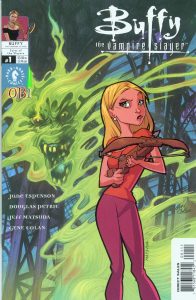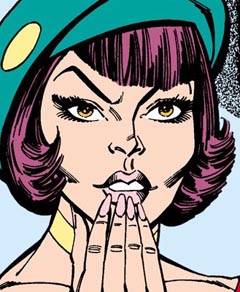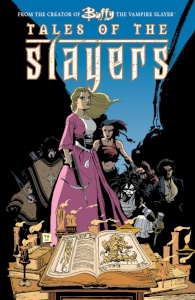The “Tales of the Slayers” comics – a trade paperback in November 2001 and the “Broken Bottle of Djinn” one-shot in October 2002 – are primarily written by “Buffy” and “Angel” TV writers, which creates a high expectation level. These nine stories are fun, easy reads, but not as deep or substantial as one might hope for.
The highlight is Joss Whedon’s framing stories for the trade paperback. He starts with the First Slayer, who is alone in the world but takes comfort in knowing that future Slayers will follow her. So she’s not alone in a historical sense. He ends the volume with Melaka Fray, who comes upon a collected book of Watcher’s Journals and learns all about past Slayers – her own Tales of the Slayers, as it were – and likewise is comforted by the knowledge that she’s not alone. Absent an ongoing “Fray” series, I’ll take whatever tidbits of Mel I can get, and it’s nice that this yarn is brought to life by the familiar Karl Moline/Andy Owens/Dave Stewart team. Honestly, I don’t know if I’d accept anyone else doing the art for our favorite Future Slayer.
The highlight of the in-between tales is Jane Espenson’s “Presumption.” It’s mostly about a courtship dance in the Victorian era, setting us up for the inevitable twist where the Slayer must dispatch her courtier, whom she knows to be a vampire. But Espenson pulls a brilliant twist on top of that telegraphed twist, and when we reflect on the title, we feel properly chastised.
Other than the Fray piece, Douglas Petrie’s “Nikki Goes Down!” is the most eye-catching in the TPB’s table of contents, since it follows a Slayer we know from the TV series. It’s disappointingly simple, although it is notable that Nikki Wood rides on the back of a giant bat – presumably a vampire bat, raising the notion that a sufficiently ancient vampire can turn into a bat in the Buffyverse.

Espenson and Petrie team up for the one-shot “Broken Bottle of Djinn,” which has special meaning for me since I use “djinn” in Scrabble any chance I get. Also, it’s the only “Tale” to feature our favorite Slayer, and it’s set in Season 2, thus teasing a nostalgia trip. Unfortunately, it ain’t great. Buffy and magic novice Willow are briefly involved in sending an evil genie through a portal to who-knows-where. Then we see how the genie came to be trapped in this locker that is acquired by Sunnydale High: A Slayer during World War II put the bottle there. Here’s something to file away in your knowledge of Slayer lore: The Office of Strategic Services (the predecessor of the CIA) knows about Slayers.
Speaking of Buffyverse lore, David Fury’s “The Glittering World” ends with a fun tidbit. After a dour story of an Old West Slayer and vampire killing each other in battle, we cut to the ageless Richard Wilkins planning a new city. A padre warns him that this is cursed land, but Wilkins isn’t worried (or perhaps he likes that it’s cursed), and he mulls whether to call it “Happydale” or “Sunny Acres.”

Many of these tales function as fables. In Whedon’s “Righteous,” written in rhyming poetry, superstitious townsfolk burn a Slayer at the stake even though she has saved the town from a vampire scourge. They pay the price for their folly in the way you’d expect.
Amber Benson, Tara actress and co-writer of the “Willow & Tara” comics, expands her horizons with the meditative “The Innocent.” A Slayer is assigned by her lover (and presumably Watcher?) to kill a vampire, but the “vampire” is just a selfish rich dude the guy wanted to get rid of. The Slayer despairs that her career of killing vampires won’t put a dent in the amount of evil among mankind.
Likewise exploring human evil is Rebecca Rand Kirshner’s “Sonnenblume.” A German Slayer is indoctrinated into Nazism but gradually realizes who is truly evil, despite what she has been taught. It makes me wonder if there’s some aspect of Slayerhood that provides special insight into the good/evil dichotomy, since we rarely hear about Slayers using their powers for bad, and it was not common for young Nazis to offend the status quo and think for themselves.
Collectively, “Tales of the Slayers” is a quick and enjoyable read – and the Fray piece is especially tasty – but overall these stories will fade from memory like vampire dust in the wind.
“Tales of the Slayers” TPB: 3.5 stars
“The Broken Bottle of Djinn”: 2.5 stars
Click here for an index of all of John’s “Buffy” and “Angel” reviews.

